The Personalized Packaging Market is estimated to be valued at USD 41.0 billion in 2025 and is projected to reach USD 77.7 billion by 2035, registering a compound annual growth rate (CAGR) of 6.6% over the forecast period.
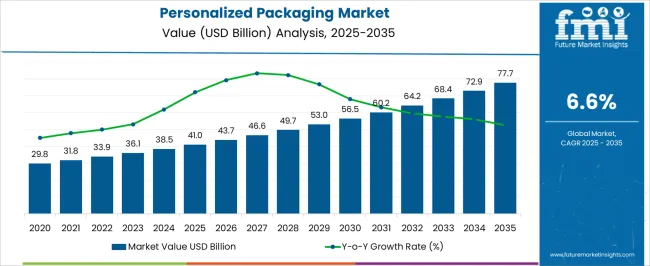
| Metric | Value |
|---|---|
| Personalized Packaging Market Estimated Value in (2025 E) | USD 41.0 billion |
| Personalized Packaging Market Forecast Value in (2035 F) | USD 77.7 billion |
| Forecast CAGR (2025 to 2035) | 6.6% |
The personalized packaging market is expanding steadily as brands across sectors increasingly focus on consumer engagement, premiumization, and differentiation at the shelf level. Rapid digitalization in printing technologies has enabled high speed customization with low minimum order quantities, encouraging adoption among small and large enterprises alike.
Personalized packaging enhances brand recall and emotional connection, particularly in industries where consumer experience plays a central role. Additionally, the rise of e commerce, direct to consumer models, and influencer driven marketing has fueled demand for visually distinct and tailor made packaging formats.
As sustainability continues to influence purchasing decisions, brands are integrating eco friendly substrates into personalized formats to balance impact with appeal. The future outlook remains promising with growing emphasis on hyper personalization, variable data printing, and integrated branding solutions that reinforce both storytelling and customer loyalty.
The market is segmented by Packaging Type and End-User Industry and region. By Packaging Type, the market is divided into Bottles, Containers & Jars, Bags & Pouches, Cartons, Envelopes, and Boxes. In terms of End-User Industry, the market is classified into Food, Beverage, Pharmaceutical, Personal Care, Logistics, and Others. Regionally, the market is classified into North America, Latin America, Western Europe, Eastern Europe, Balkan & Baltic Countries, Russia & Belarus, Central Asia, East Asia, South Asia & Pacific, and the Middle East & Africa.
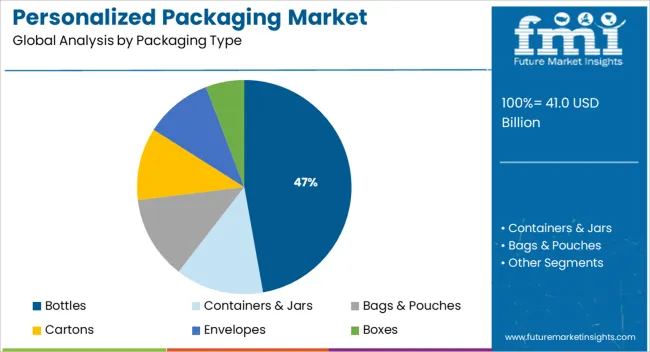
The bottles segment is projected to contribute 47.20% of the total market revenue by 2025 within the packaging type category, positioning it as the leading format. This dominance is attributed to the increasing demand for personalized labeling and product presentation in sectors such as beverages, health supplements, and cosmetics.
Bottles offer a versatile canvas for digital printing and embossing technologies that enable brand centric designs and limited edition packaging. Their rigid structure allows for enhanced durability and premium tactile feel, supporting product positioning in both retail and e commerce environments.
The popularity of customized bottles in gift packaging and event based product launches has further reinforced their leadership. As brands continue to invest in customer centric packaging experiences, bottles remain the preferred medium due to their adaptability and shelf impact.
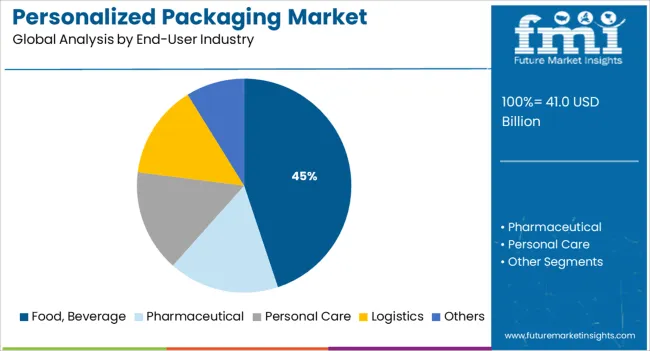
The food and beverage segment is expected to account for 44.90% of the total market revenue by 2025 under the end user industry category, making it the most dominant sector. This growth is driven by evolving consumer expectations for personalized products and packaging that reflects lifestyle, dietary preferences, or celebratory occasions.
Brands in this space are leveraging customization to build stronger customer relationships, promote seasonal variants, and differentiate SKUs in competitive retail settings. The ability to tailor packaging for special events or promotional campaigns has enhanced consumer perception and purchase intent.
In addition, regulatory support for transparent labeling and traceability has aligned well with the personalized packaging trend. With consumer centricity becoming a core strategy in food and beverage branding, this industry continues to lead in adopting innovative personalized packaging solutions.
Personalized packaging market statistics show sluggish growth during the forecast period as compared to the historical period. Between 2020 and 2025, the market was expanding at a CAGR of 6.6%.
The market still offers some excellent opportunities for the manufacturers of personalized packaging, despite the slowdown in growth. From USD 29.8 billion in 2020, the sector is anticipated to grow to USD 77.7 billion by 2035.
The rising need for package modification to guarantee the product's safety, which is further fueled by an increase in international exports and imports, accounts for a sizable share of the personalized packaging market.
Short Term (2025 to 2029): Manufacturers in the region are expanding their capabilities and production capacity to strengthen their position in the rapidly expanding market. Due to this, the market is expected to reach USD 53 billion by 2029.
Medium Term (2029 to 2035): The expansion of e-retail usage globally is contributing to the market share growth in the coming years.
Long-term (2035 to 2035): Due to the need to establish a brand identity in the face of intense market competition, more and more brand owners are deciding to forgo traditional packaging in favor of bespoke choices.
During the forecast period, the global personalized packaging market is anticipated to grow from USD 410 billion in 2025 to USD 77.7 billion by 2035, with a CAGR of 5.28%.
Electronic companies use distinctive packaging designs for their products, in order to entice and keep customers throughout the buying process and ensure good product quality.
Mobile enterprises need individualized packaging that is strong, tamper-evident, and very secure. Customer brands, from those in fast-moving consumer goods to those at the forefront of high-end luxury items, are pulling the levers of personalized packaging.
As businesses become slightly more cognizant of consumers' thoughts as a result of branding campaigns, the demand for personalized packaging is likely to grow. The beverage and food industries have shown the strongest inclinations toward personalization packaging.
Personalized packaging may improve brand awareness and help companies interact with their customers, but new designs need a lot more time and effort from companies, which may drive up manufacturing costs. For this, determining the optimal package design and marketing approach requires a significant investment of marketing resources.
Personalized packaging campaigns that are unsuccessful with customers can be time- and money-consuming, as well as detrimental to corporate profitability. Businesses must also stay up to date on the most recent personalized packaging trends to avoid printing outdated or obsolete packaging.
By packaging type, the sector for bottles is predicted to have the highest revenue share and a CAGR of 4.5% during the forecast period. Custom bottles provide a visual representation that may embody the brand and highlight package design by taking on a new shape and incorporating a logo into a bottle.
While glass bottles cannot be sterilized and reused, plastic bottles can be recycled, which is a major factor in enhancing the sustainability of personalized packaging. Additionally, it is anticipated that the demand for personalized packaging in bottles is likely to expand due to the growing demand for convenience packaging and ready-to-drink beverages.
With a predicted CAGR of 6.1% and a higher revenue share than the other segments, it is anticipated that the beverage segment would surpass them. When employing personalized beverage packaging, the substantial global trend toward beverages helps to increase brand awareness and sales.
Personalized packaging companies now have the chance to cater to a wide range of consumer needs due to the customization trend. The adoption of personalized packaging has expanded as a result of shifting customer tastes, such as the need for something with a distinctive and one-of-a-kind look and feel.
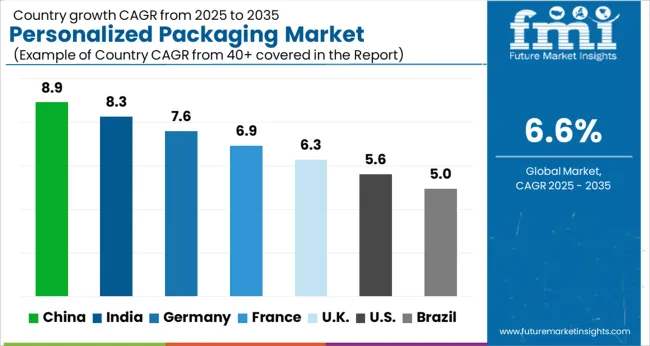
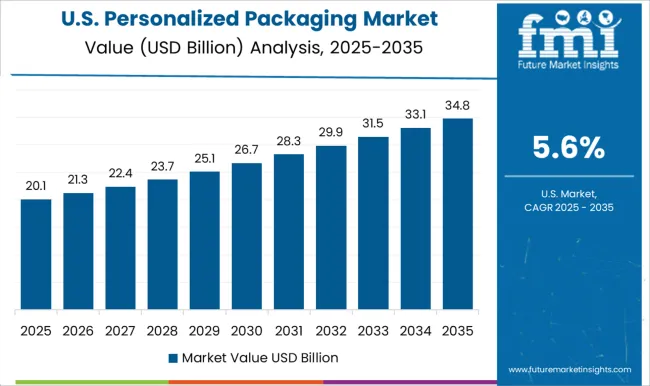
In North America, the market for personalized packaging is anticipated to be dominated by the USA. This can be linked to the rising demand for personalized packaging options in the food and beverage sector, as well as the accessibility of cutting-edge packaging materials and technologies in the nation.
With a CAGR of 5.5%, the market for personalized packaging in North America is anticipated to expand significantly during the forecast period. The adoption of personalized packaging is anticipated to rise in North America as a result of rising disposable income.
Additionally, it is anticipated that the presence of top manufacturers in the area is likely to assist the expansion of the USA market.
The United Kingdom market for personalized packaging is anticipated to expand at a CAGR of 4.5% during the forecast period. This growth can be related to the increasing consumer buying power, the rising utilization of digital printing technology for packaging, and the rising need for appealing packaging designs for product promotion.
Moreover, the United Kingdom market for customized packaging has expanded as a result of the expansion of the e-commerce sector.
| Countries | CAGR (2025 to 2035) |
|---|---|
| Japan | 4.4% |
| Korea | 6.3% |
| China | 14.4% |
| India | 22.5% |
The desire for personalized packaging solutions is being fueled by the country's growing e-commerce industry, which needs specialized packaging to set its items apart from its competitors. This trend is accelerated by the expanding usage of packaging technology, such as virtual reality and 3D printing, to produce distinctive and eye-catching containers.
Moreover, the desire for more appealing packaging to be supplied with orders is also increasing due to the growing popularity of online shopping, which is further boosting the market expansion for customized packaging in China.
The market is expanding as a result of the rising demand for personalized packaging. These packaging solutions give the product a distinctive appearance and aid in building a solid brand identity. The rise of small and medium-sized personalized packaging enterprises also contributes to the APAC industry's expansion.
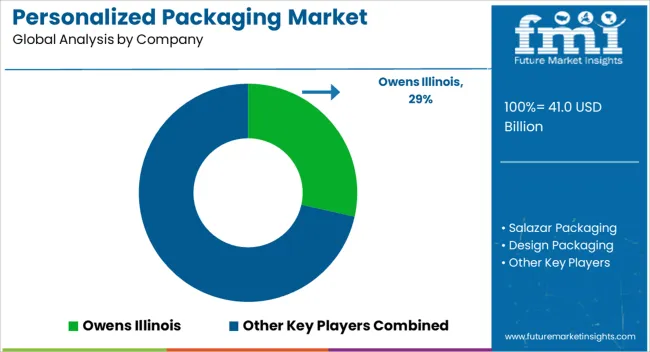
Manufacturers of personalized packaging contact customers personally, which promotes strategic planning and creative packaging solutions.
The personalized packaging trend has been embraced by numerous businesses across numerous industrial sectors in an effort to profit from it. The value of strategic packaging is one of the alluring customer value propositions that organizations have been seeking to leverage for distinctive positioning.
Moreover, customer interactions only become more delicate over time, given the intense competition that customized packaging creates. The unquenchable desire to interact personally with businesses is one of the key factors propelling development for industry participants in personalized packaging.
For instance, to expand its custom packaging business, Packhelp raised USD 38.5 million in investment in November 2024. Due to the rise of e-commerce and on-demand delivery, Packhelp has grown into a company that assists even the tiniest businesses in wrapping their products in eye-catching custom packaging and counting giants like H&M and Uber Eat among its clients.
The usage of linked packaging to reach clients from a digital marketing perspective has presented a wonderful innovation potential for the leading players in the personalized packaging industry.
Moreover, personalized packaging with NFC- and RFID-enabled tags is anticipated to be the next generation of intelligent packaging due to its anti-counterfeiting and anti-theft qualities. The use of unusual shapes and sizes for bespoke packaging, together with the typography and glossy or matte printing on luxury boxes, are additional advancements in the global market for the packaging of alcoholic beverages.
Recent Developments:
The global personalized packaging market is estimated to be valued at USD 41.0 billion in 2025.
The market size for the personalized packaging market is projected to reach USD 77.7 billion by 2035.
The personalized packaging market is expected to grow at a 6.6% CAGR between 2025 and 2035.
The key product types in personalized packaging market are bottles, containers & jars, bags & pouches, cartons, envelopes and boxes.
In terms of end-user industry, food, beverage segment to command 44.9% share in the personalized packaging market in 2025.






Our Research Products

The "Full Research Suite" delivers actionable market intel, deep dives on markets or technologies, so clients act faster, cut risk, and unlock growth.

The Leaderboard benchmarks and ranks top vendors, classifying them as Established Leaders, Leading Challengers, or Disruptors & Challengers.

Locates where complements amplify value and substitutes erode it, forecasting net impact by horizon

We deliver granular, decision-grade intel: market sizing, 5-year forecasts, pricing, adoption, usage, revenue, and operational KPIs—plus competitor tracking, regulation, and value chains—across 60 countries broadly.

Spot the shifts before they hit your P&L. We track inflection points, adoption curves, pricing moves, and ecosystem plays to show where demand is heading, why it is changing, and what to do next across high-growth markets and disruptive tech

Real-time reads of user behavior. We track shifting priorities, perceptions of today’s and next-gen services, and provider experience, then pace how fast tech moves from trial to adoption, blending buyer, consumer, and channel inputs with social signals (#WhySwitch, #UX).

Partner with our analyst team to build a custom report designed around your business priorities. From analysing market trends to assessing competitors or crafting bespoke datasets, we tailor insights to your needs.
Supplier Intelligence
Discovery & Profiling
Capacity & Footprint
Performance & Risk
Compliance & Governance
Commercial Readiness
Who Supplies Whom
Scorecards & Shortlists
Playbooks & Docs
Category Intelligence
Definition & Scope
Demand & Use Cases
Cost Drivers
Market Structure
Supply Chain Map
Trade & Policy
Operating Norms
Deliverables
Buyer Intelligence
Account Basics
Spend & Scope
Procurement Model
Vendor Requirements
Terms & Policies
Entry Strategy
Pain Points & Triggers
Outputs
Pricing Analysis
Benchmarks
Trends
Should-Cost
Indexation
Landed Cost
Commercial Terms
Deliverables
Brand Analysis
Positioning & Value Prop
Share & Presence
Customer Evidence
Go-to-Market
Digital & Reputation
Compliance & Trust
KPIs & Gaps
Outputs
Full Research Suite comprises of:
Market outlook & trends analysis
Interviews & case studies
Strategic recommendations
Vendor profiles & capabilities analysis
5-year forecasts
8 regions and 60+ country-level data splits
Market segment data splits
12 months of continuous data updates
DELIVERED AS:
PDF EXCEL ONLINE
Packaging Supply Market Size and Share Forecast Outlook 2025 to 2035
Packaging Testing Services Market Size and Share Forecast Outlook 2025 to 2035
Packaging Tubes Market Size and Share Forecast Outlook 2025 to 2035
Packaging Jar Market Forecast and Outlook 2025 to 2035
Packaging Barrier Film Market Size and Share Forecast Outlook 2025 to 2035
Packaging Films Market Size and Share Forecast Outlook 2025 to 2035
Packaging Laminate Market Size and Share Forecast Outlook 2025 to 2035
Personalized Immunotherapy Market Size and Share Forecast Outlook 2025 to 2035
Packaging Burst Strength Test Market Size and Share Forecast Outlook 2025 to 2035
Packaging Tapes Market Analysis - Size, Share, & Forecast Outlook 2025 to 2035
Packaging Materials Market Size and Share Forecast Outlook 2025 to 2035
Packaging Labels Market Size and Share Forecast Outlook 2025 to 2035
Packaging Equipment Market Size and Share Forecast Outlook 2025 to 2035
Packaging Resins Market Size and Share Forecast Outlook 2025 to 2035
Personalized Toys Market Size and Share Forecast Outlook 2025 to 2035
Packaging Inspection Systems Market Size and Share Forecast Outlook 2025 to 2035
Packaging Design And Simulation Technology Market Size and Share Forecast Outlook 2025 to 2035
Packaging Suction Cups Market Size and Share Forecast Outlook 2025 to 2035
Packaging Straps and Buckles Market Size and Share Forecast Outlook 2025 to 2035
Personalized Nutrition Market - Size, Share, and Forecast Outlook 2025 to 2035

Thank you!
You will receive an email from our Business Development Manager. Please be sure to check your SPAM/JUNK folder too.
Chat With
MaRIA